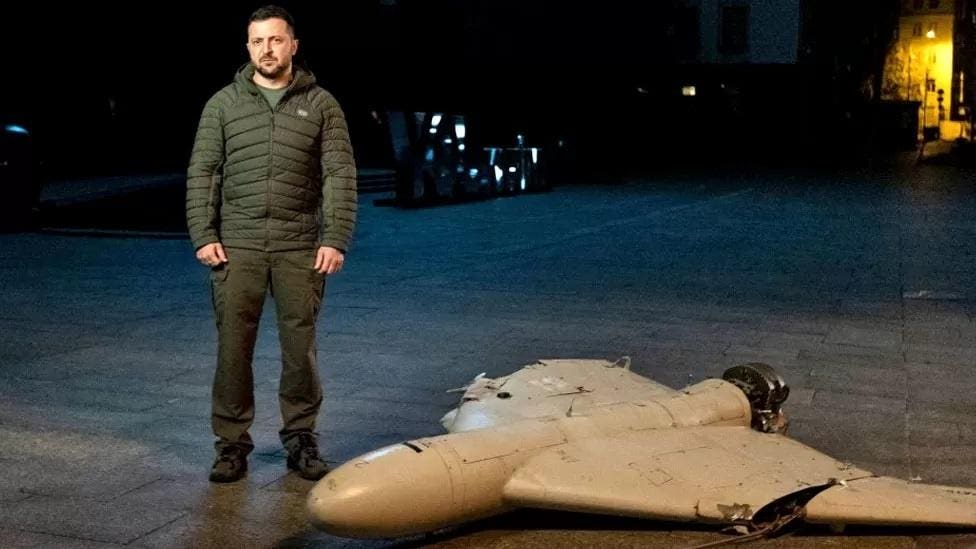New video shows the test launch of a Chinese made kamikaze drone, the Sunflower-200. The footage shared on Twitter shows the drone taking off with the assistance of a rocket booster, and (presumably) hitting a target some distance away. The weapon, apparently a copy of the Iranian Shahed-136, was previously only known from pictures at Russia’s ARMY-2023 show in Moscow last month. The latest evidence shows that this is a real weapon at an advanced stage of development, and that could be cause for concern in Ukraine.
The Shahed-136 is a vital weapon in Russia’s war against Ukraine’s cities. During the winter, repeated strikes caused significant power outages, and recently Shaheds have hit grain storage facilities in Odessa. Russia only has limited capacity to produce big, expensive cruise and ballistic missiles, but the small, inexpensive drones can be procured and launched in large number, and while many are shot down, some still get through. In the latest attack Ukraine claimed to have shot down 28 out of 33 Shaheds. To keep up the pressure, Russia needs to keep acquiring the drones in large numbers.
Around 2,000 Shaheds have been launched so far. The initial Shaheds were imported direct from Iran, but several recent reports have indicating that Russia is now assembling their own version under license. White House analysts identified a factory complex which will supposedly be used for Shahed production but there are real doubts over how serious this enterprise is. Early reports described how the Russian team first found they did not have a forklift truck to unload crated components from Iran; when they sourced a forklift, they could not find a qualified driver. The drones are currently assembled by underpaid high-school students and it is doubtful whether the operation will meet the ambitious production goals.
A recent report of a Shahed crash in Romania may also indicate quality control issues with the Russian-made drones. A Chinese-made alternative might be an attractive option, if the price is right. Estimates for the cost of Iranian Shahed range from $20,000 to $50,000, compared to around $980,000 for a Kalibr cruise missile.
From the few details released, the Sunflower-200 is not a direct copy of the Shahed, but is something of an upgrade. It has similar performance, cruising at 160-220 km/h ( 100 – 135 mph) with a range variously given as 1500 or 2000 kilometers (around 900 – 1,250 miles) compared to 1,000 to 2,000 kilometres (about 600 – 1,250 miles) for the Iranian drone, and the 40-kilo/88-pound warhead is similar. Like the Shahed, the Sunflower can be launched with a rocket unit, and may also be capable of catapult launch. A handout at ARMY 2023 said the drones were fired from an eight-unit launcher, suggesting that it was meant for mass attacks.
The biggest difference is that the Sunflower appears to have a smart guidance unit. The Shahed is a pseudo-missile, that is, it is given a set of target co-ordinates at launch, rather than a true loitering munition able to change target or seek out objects on the ground. None of the versions seen in Ukraine have cameras or other sensors.
The Sunflower-200 has both daylight and thermal imaging cameras, and a machine learning system which allows it to seek out a specific target. This may be no more sophisticated than the Digital Scene Matching Area Correlator developed for the Tomahawk cruise missile way back in the 1970s, providing navigation when satellite guidance is jammed. But it might be sophisticated enough to pick out specific targets like air defence assets or artillery. The camera can also transmit images to an operator up to 50 km/30 miles away, allowing them to direct the Sunflower on to a target like a giant FPV kamikaze drone or Lancet loitering munition for short-range attacks.
Very little information has been released about the Sunflower; we do not even know what company makes it. One interpretation is that China is waking up to the power of long-range loitering munitions and simply wishes to add them to its portfolio. The success of Shahed, and their Ukrainian equivalents used to hit Moscow, may well be a harbinger of the future and a useful addition to China’s drone exports.
There is a more obvious take. China does not official supply Russia with weapons, though it finds indirect routes to give assistance, and the name Sunflower, an obvious reference to the national flower of Ukraine, is surely significant. Its presence at a Russian arms show is an indication of the type of help China might provide in this conflict. The new video shows that the Sunflower is far more than just vaporware, and may only be months away from production – if the price and the political climate are right.
Read the full article here





